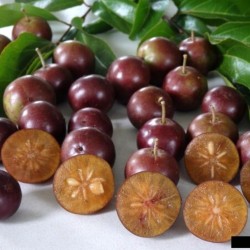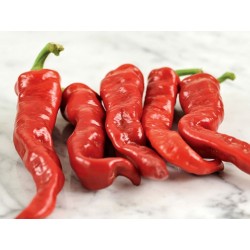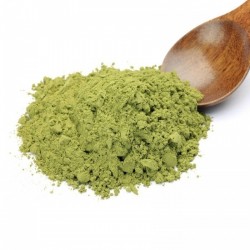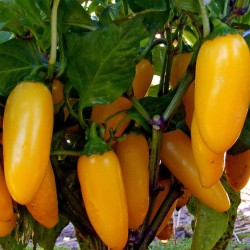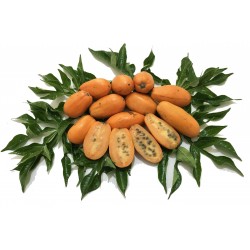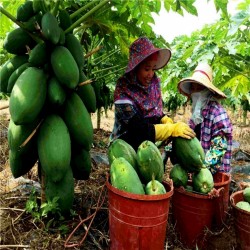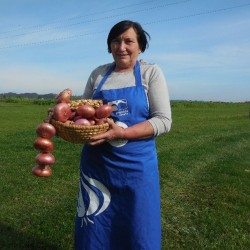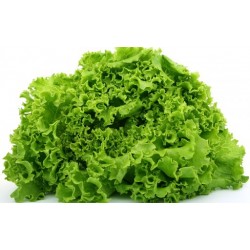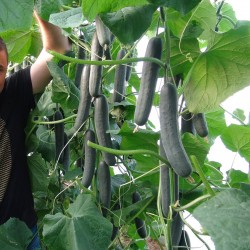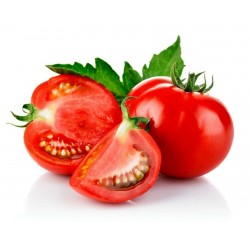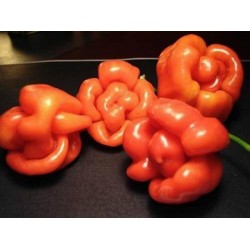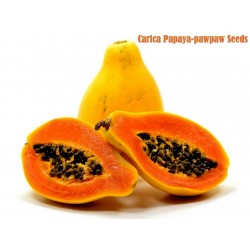
Papaya, Papaw, or Pawpaw...
السعر
2.25 €
SKU: V 22 N
Seeds Gallery Com,
5/
5
<h2><strong>Papaya, Papaw, or Pawpaw Seeds (Carica papaya)</strong></h2>
<h2><span style="color:#ff0000;"><strong>Price for Package of 10 or 100 seeds.</strong></span></h2>
<p>Papaya (Carica papaya L.) - Deliciously sweet with musky undertones and a soft, butter-like consistency, it is no wonder the papaya was reputably called the "fruit of the angels" by Christopher Columbus. Once considered quite exotic, they can now be found in markets throughout the year. Although there is a slight seasonal peak in early summer and fall, papaya trees produce fruit year-round. </p>
<p>Papayas are fruits that remind us of the tropics, the regions of the world in which they are grown. Once considered an exotic fruit, papayas' rise in popularity has made them much more available. Papaya fruits are good sources of Vitamin A, B and C. </p>
<p>Papayas are spherical or pear-shaped fruits that can be as long as 20 inches. The ones commonly found in the market usually average about 7 inches and weigh about one pound. Their flesh is a rich orange color with either yellow or pink hues. </p>
<p>Papaya has a wonderfully soft, butter-like consistency and a deliciously sweet, musky taste. Inside the inner cavity of the fruit are black, round seeds encased in a gelatinous-like substance. Papaya's seeds are edible, although their peppery flavor is somewhat bitter. </p>
<p>The fruit, as well as the other parts of the papaya tree, contain papain, an enzyme that helps digest proteins. This enzyme is especially concentrated in the fruit when it is unripe. Papain is extracted to make digestive enzyme dietary supplements and is also used as an ingredient in some chewing gums. </p>
<h2><strong>How To Grow Papaya From Seed</strong></h2>
<p>Select a sunny and sheltered place in your garden. That's right, in your garden. Don't start them in pots!</p>
<p>Papayas don't transplant well. Anything that disturbs the roots of papayas really sets them back. They just hate it. The most foolproof way to grow papayas is to simply plant them where they are to live.</p>
<p>Papaya trees are very, very hungry. That means they need very good soil, rich in organic matter and nutrients.</p>
<p>If you don't have fabulous soil, make some. Dig a hole half a meter across and fill it with a mix of good compost and soil. Actually, make at least two or three such planting beds in different locations.</p>
<p>Now sprinkle on some of your seeds. A couple of dozen per bed is a good amount. Cover the seeds lightly with more compost, and then mulch the patch well. The seeds usually take about a couple of weeks to germinate, and may take longer.</p>
<p>Soon you will notice that your seedlings are very different in size and vigor. That's why we planted so many. Start culling the weaker ones. Pull them out while still small, or cut bigger ones down to the ground. Only keep the very best.</p>
<p>At this stage you should keep about half a dozen plants. Papaya plants can be male, female, or bisexual, and you want to make sure that you have some females or bisexual plants amongst your seedlings. The male papayas don't bear fruit.</p>
<p>Papayas start flowering when they are about one meter tall. The male's flower first. Male flowers have long, thin stalks with several small blooms. Female flowers are usually single blooms, bigger, and very close to the trunk. </p>
<p>Cull most of the male plants. You only need one male for every ten to fifteen female plants to ensure good pollination.</p>
<p>And that's it. You should end up with one very strong and healthy female plant per bed. (And a male plant somewhere...) If the weather is warm enough, and if you are growing your papayas in full sun and in good soil, then you could be picking the first ripe fruit within 10 months.</p>
<p><strong>How much water?</strong></p>
<p>Papayas have large soft leaves. They evaporate a lot of water in warm weather, so they need a lot of water. But unfortunately, papayas are very susceptible to root rot, especially in cool weather. Overwatering is the most common reason for problems when growing papayas.</p>
<p>It depends on the temperature and on the overall health and vigor of the plant. A healthier plant will cope better, but in general you should be careful not to overwater during periods of cool weather.</p>
<p><strong>Growing Papaya In Cooler Climates</strong></p>
<p>If you get at least long hot summers you could grow papaya just as an ornamental plant. In this case you would start them in a pot indoors to gain extra time. Plant them out against a sun-facing wall and enjoy the tropical look. However, you won't be able to keep your papaya alive long enough to get fruit.</p>
<p>The only other option is growing papaya in a huge pot, and to keep the pot in a heated greenhouse in winter. You may also grow papaya as an annual decorative plant.</p>
<div>
<table border="1" cellspacing="0" cellpadding="0"><tbody><tr><td colspan="2" valign="top" width="100%">
<p><span style="color:#008000;"><strong>Sowing Instructions</strong></span></p>
</td>
</tr><tr><td valign="top" nowrap="nowrap">
<p><span style="color:#008000;"><strong>Propagation:</strong></span></p>
</td>
<td valign="top">
<p><span style="color:#008000;">Seeds / Cuttings</span></p>
</td>
</tr><tr><td valign="top" nowrap="nowrap">
<p><span style="color:#008000;"><strong>Pretreat:</strong></span></p>
</td>
<td valign="top">
<p><span style="color:#008000;">0</span></p>
</td>
</tr><tr><td valign="top" nowrap="nowrap">
<p><span style="color:#008000;"><strong>Stratification:</strong></span></p>
</td>
<td valign="top">
<p><span style="color:#008000;">0</span></p>
</td>
</tr><tr><td valign="top" nowrap="nowrap">
<p><span style="color:#008000;"><strong>Sowing Time:</strong></span></p>
</td>
<td valign="top">
<p><span style="color:#008000;">all year round</span></p>
</td>
</tr><tr><td valign="top" nowrap="nowrap">
<p><span style="color:#008000;"><strong>Sowing Depth:</strong></span></p>
</td>
<td valign="top">
<p><span style="color:#008000;">0.5 cm</span></p>
</td>
</tr><tr><td valign="top" nowrap="nowrap">
<p><span style="color:#008000;"><strong>Sowing Mix:</strong></span></p>
</td>
<td valign="top">
<p><span style="color:#008000;">Coir or sowing mix + sand or perlite</span></p>
</td>
</tr><tr><td valign="top" nowrap="nowrap">
<p><span style="color:#008000;"><strong>Germination temperature:</strong></span></p>
</td>
<td valign="top">
<p><span style="color:#008000;">about 25-28 ° C</span></p>
</td>
</tr><tr><td valign="top" nowrap="nowrap">
<p><span style="color:#008000;"><strong>Location:</strong></span></p>
</td>
<td valign="top">
<p><span style="color:#008000;">bright + keep constantly moist not wet</span></p>
</td>
</tr><tr><td valign="top" nowrap="nowrap">
<p><span style="color:#008000;"><strong>Germination Time:</strong></span></p>
</td>
<td valign="top">
<p><span style="color:#008000;">2-4 Weeks</span></p>
</td>
</tr><tr><td valign="top" nowrap="nowrap">
<p><span style="color:#008000;"><strong>Watering:</strong></span></p>
</td>
<td valign="top">
<p><span style="color:#008000;">regular watering during the growth period + dry between waterings</span></p>
</td>
</tr><tr><td valign="top" nowrap="nowrap">
<p><span style="color:#008000;"><strong> </strong></span></p>
</td>
<td valign="top">
<p><br /><span style="color:#008000;"><em>Copyright © 2012 Seeds Gallery - Saatgut Galerie - Galerija semena. All Rights Reserved.</em></span></p>
</td>
</tr></tbody></table></div>
V 22 N (10 S)


